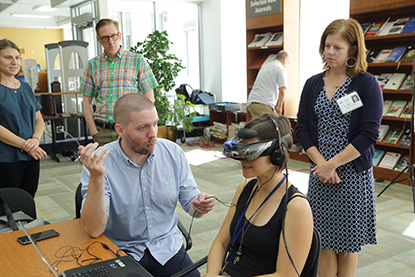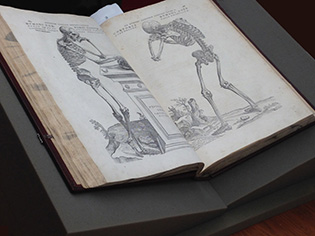NIH Research Festival: Into the Future and Out of the Past
Festival Goers Discover More Than Scientific Lectures
A Walk in the Future: Virtual Reality and Technology at the NIH Library
We’re not talking just three-dimensional (3-D) glasses anymore, folks. Yes, okay, you still have to wear the glasses (and they’re pretty hefty, too). But with new features such as accelerometers to track your speed, gyroscopes to adjust to changes in your head tilt, and infrared trackers to catch your movement, the experience of virtual reality can be immersive, vibrant, and even interactive, letting you enter fanciful worlds or directly interact with scientific data in 3-D.

CREDIT: ERNIE BRANSON
During the Research Festival, people got to try out virtual reality technologies at the NIH Library.
During the NIH Research Festival, members of the Virtual and Augmented Reality Interest Group (VARIG) brought their virtual reality setups to the NIH Library, allowing visitors to try out the experience and imagine what the technology could bring to their research. One group, the National Human Genome Research Institute’s Immersive Virtual Environment Testing Area, led by Susan Persky, is exploring ways to apply these technologies to behavioral research, using virtual avatars to study how people interact in various health-relevant situations.
But the applications of this technology—whether they be studying and evaluating movement or simply interacting with a 3-D model of an organism, cell, or protein in virtual space—offer possibilities limited only by what you can dream up.
On the other hand, if you’d rather hold your model in not-so-virtual reality, you can always have the NIH Library print it out, in 3-D, ready to bring to your next presentation or to share with colleagues!
To find out more about adding virtual reality to your research, you can join the VARIG LISTSERV at https://list.nih.gov/cgi-bin/wa.exe?SUBED1=VARIG&A=1. For more on the NIH Library’s 3D printing services, go to https://nihlibrary.nih.gov/3dprinting. For information on the NIH 3D Print Exchange, go to http://3dprint.nih.gov/.
A Walk in the Past: NLM’s History of Medicine Collections
Located in the southeast corner of the NIH campus, the National Library of Medicine (NLM) serves the world’s medical-research community in many ways. Most visible to the NIH and extramural communities is its role indexing peer-reviewed biomedical research.
But the NLM is also responsible for archiving historical biomedical documents, a task that includes not only preserving a variety of materials from centuries past but also collecting and preserving modern records and “born digital” materials, such as websites and blogs, for future research.
During the NIH Research Festival, the NLM hosted tours of the History of Medicine collections, guiding visitors through its current exhibition (documents relating to the history of domestic violence) to the incunabula room, where the oldest and most precious of NLM’s collections are housed and available for interested visitors to see and learn about through the expertise of NLM staff.

PHOTO BY: LESLEY EARL, NCI
One of the rare books in National Library of Medicine’s collections is De Humani Corporis Fabrica by Andreas Vesalius, published in 1543. (To read more about it, go to https://circulatingnow.nlm.nih.gov/2014/12/16/nlms-unique-de-fabrica).
Some of the rare books held there include hand-written medical documents dating back nearly 1,000 years and more modern works such as first editions of Charles Darwin’s On the Origin of Species and Florence Nightingale’s Notes on Nursing.
The most challenging materials to preserve, however, are not necessarily the oldest in the collection. The problem documents can be much more recent: printed on poor quality, acidic paper (and occasionally held together with ordinary Scotch tape), some precious documents from the 20th century are already fading away, with even the best preservation techniques only slowing their inevitable decline.
And what about the latest in research, with some journals online-only? As file types and computing standards change, the NLM is actively preserving these documents for centuries to come. Visit the NLM to learn more about its work. You will be warmly welcomed.
For more information about NLM, go to https://www.nlm.nih.gov/. For more on the History of Medicine Division and its online exhibitions and digital collections, go to https://www.nlm.nih.gov/hmd/.
This page was last updated on Tuesday, April 12, 2022
